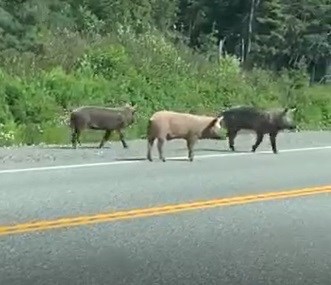The push continues to prevent the establishment of one of the most serious threats that Ontario's natural environment could face — wild pigs, says the MNRF in a news release.
"Destructive, clever, and supremely adaptable, invasive wild pigs compete with native wildlife for food and shelter. They prey on native plants, subjecting natural areas to enormous damage from digging, rooting, trampling, and wallowing," according to the ministry.
Wild pigs can also spread diseases to native wildlife and livestock. They have been sighted near Temagami, but mostly live in the south.
“Once a wild pig population establishes itself and starts reproducing, it can be virtually impossible to eradicate if left unchecked,” said Dr. Erin Koen, a wildlife researcher with the Ontario Ministry of Natural Resources and Forestry.
Populations of wild pigs have been established in many regions of North America. In the U.S., wild pigs cause an estimated $1.5 billion in damage and control costs each year.
“Fortunately, Ontario still has time to prevent the establishment of wild pig populations in the province,” Koen said.
In February, the Ministry of Natural Resources and Forestry published a proposal on the Environmental Registry of Ontario, seeking feedback to determine what actions should be taken to prevent the introduction and spread of wild pigs.
These actions may include regulating wild pigs under the Invasive Species Act. Officially regulating wild pigs as an invasive species would give the province more tools to combat these animals.
The province has been gathering data and evaluating options for addressing invasive wild pigs.
This includes a pilot study to detect these elusive animals, based on sightings that have been reported by vigilant Ontarians from across the province.
The pilot study, which launched earlier this year, involves researchers investigating high-priority sightings with on-the-ground research techniques such as baited trail cameras and conversations with members of the local community.
You can help by reporting any pig you see outside of a fence.
“I can’t tell you how impressed we’ve been with the response we’ve had so far. Our research simply wouldn’t be possible without Ontario residents reporting their sightings,” said Koen.
The province often receives comments on how hunting could potentially solve the problem. But research from other regions shows that hunting is not an effective way to eradicate wild pig populations.
“It may seem counter-intuitive, but hunting can actually speed up the spread of invasive populations,” said Koen. “Wild pigs that are exposed to hunting pressure flee into new areas and learn to avoid humans.”
As a more effective solution, when ownership cannot be determined and the animal presents a threat to native species, ecosystems, or people, the ministry is prepared to trap and remove individuals or entire groups of wild pigs — a technique that’s been proven to work well in other jurisdictions.
Early results of the pilot study indicate that some of Ontario’s wild pigs are pot-bellied pigs that have escaped from their owners.
“We’re encouraging all owners of pigs, including Eurasian wild boar farmers and domestic pig owners, to ensure they keep their pigs contained. Preventing pig escapes is one of the most important things that Ontarians can do to address this growing concern,” said Koen.
For more information on invasive wild pigs in Ontario, click here.
Ontarians are encouraged to report wild pig sightings by email at [email protected].
